If you want to have a flower at home with the habits of a predator, then the Venus flytrap is what you need. Watching a flower slam its traps is an exciting experience. Caring for the Venus flytrap at home is quite complicated, you need to not only feed the plant on time, but also provide suitable conditions during the growing season and winter dormancy.
Material Content:
Types and varieties of plants
Venus flytrap or Dionea refers to a small community of plants capable of rapid movement. In its own way, Dionea is the only representative of the species, although it has distant relatives in the person of Aldrovanda pemphigus and sundews, from which, apparently, it came from.

The natural distribution range of the Venus flytrap is small: swamps in the southern United States (Georgia, North and South Carolina, Florida). There she is on the verge of extinction. But in the room culture, Dionea is quite widespread, but mainly abroad.
In nature, Venus flytrap is a compact plant and 15cm is its largest height. From a short underground bulbous stem grows from 4 to 7 leaves, forming a rosette. Flowering is observed in the spring. The peduncle is long so that insect pollinators arriving at white flowers do not accidentally fall into the trap.
When flowering ends, new traps form at the ends of the elongated leaves. In the natural species, their inner walls have a reddish hue.After introducing into the culture by the method of hybridization and subsequent selection, hybrid forms were created, which are highly decorative. The number of plant hybrids has exceeded 25 - they differ in leaf color, shape and size of cloves, and there may be differences in plants of the same variety.
The following hybrids are most decorative:
- Red Dragon The color of leaves and traps is red-burgundy. It requires maximum illumination, otherwise the color fades.
- Low giant It has the biggest traps.
- Jaws. Traps are reddish inside and green outside. The shape of the cloves is triangular.
- Long Red Fingers. The hybrid is prone to mutation, can form crossed and intergrown traps, their shape is cupped, and the color of long teeth, which sometimes grow together, is red.
- Bristletooth. The traps are red, the cloves are rare and short, forming many children.
- Fondue. It has a high ability to mutate, so the plants within the variety can be very different from each other.
Venus flytrap: features of cultivation
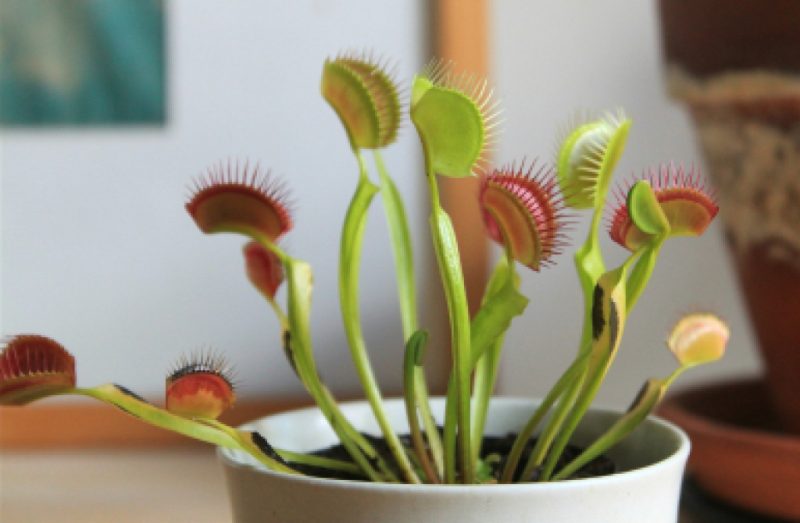
This exotic plant in nature lives in swamps, therefore it requires high humidity in a pot. There is practically no nitrogen in peat soil, and therefore the plant has adapted to eliminate its deficiency by eating animal food - small insects. In nature, there is no shortage of them, and in the room, a flower grower should provide food for the Venus flytrap.
Home Care

Caring for a venus flytrap differs in many respects from that of other indoor plants and all because of the specific conditions in which it is used to inhabit a flower. He will not tolerate even the slightest disturbance in care and can respond to it with illness and even death.
Soil requirements
Soil in the usual sense of Dionee is not needed.
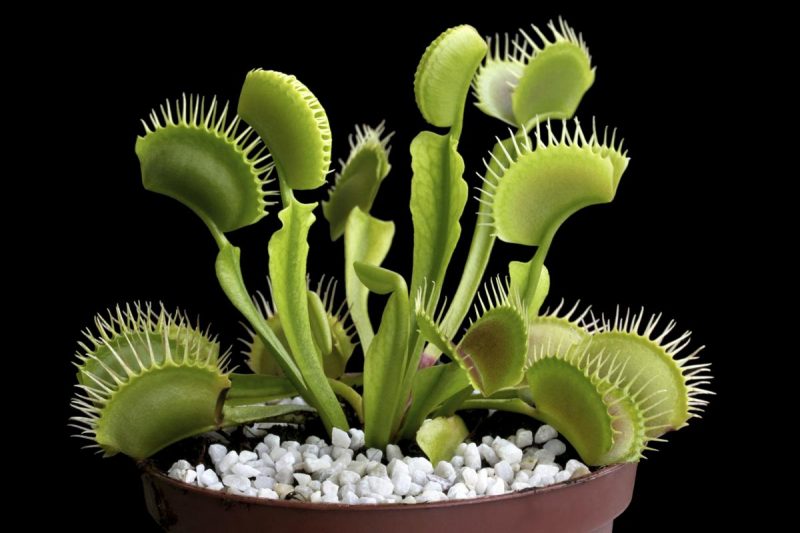
But the substrate for growing should meet the following requirements:
- acidity in the range from 3.5 to 4.5;
- composition of acidic peat in a mixture with perlite, taken in a ratio of 1: 1 or 2: 1 (perlite is preliminarily kept in distilled water for 7 days, changing it at least twice);
Sometimes they use a mixture of horse peat and quartz sand in the proportions of 2: 1 or 3: 1. Ordinary river sand is not suitable, and quartz is washed first with running, and then with distilled water. It is allowed to replace sand with ground quartz, which must be washed in the same way.
Optimal conditions
Lighting
For Dionea, sunlight is very important, without which photosynthesis is simply impossible. 4-5 hours of direct sunlight per day - the minimum rate. This amount is enough when the rest of the time the plant is also well lit. If the flycatcher does not work with such a quantity of natural light, it is necessary to illuminate it with two small fluorescent lamps mounted 20 cm above the plant or with a sodium phytolamp.
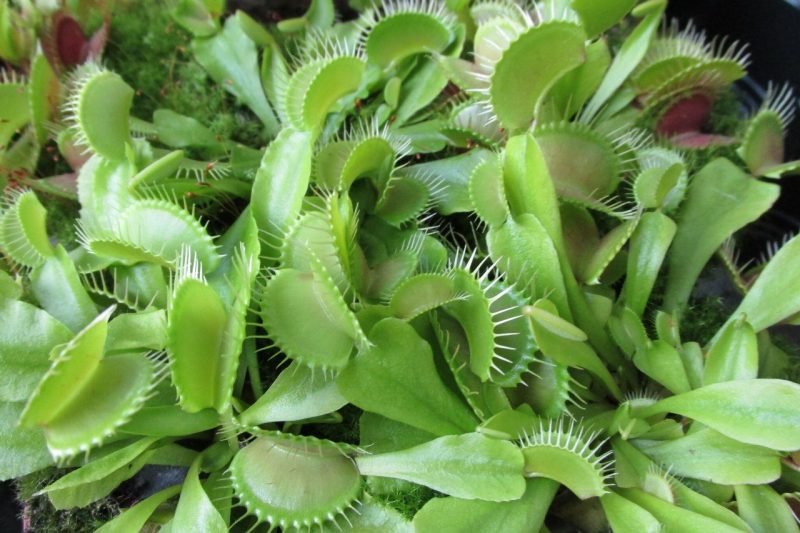
The length of daylight hours during the growing season should be from 14 to 16 hours. Don't be afraid to take your pet out in the summer onto a sunny balcony or garden. From spring to autumn, she will be best there. And she will solve the problem with outdoor nutrition herself.
The position of the flower pot in relation to the light should not change. You cannot rotate it.
Some gardeners place dionea in a closed aquarium or florarium. This content can be detrimental to the plant due to the lack of air exchange and high humidity. In extreme cases, you can use a low aquarium without a lid, be sure to adjust the watering.
Humidity
For Dionei, air humidity can be in a wide range: from 35 to 70%. The plant has a positive attitude to spraying with water, and when kept outdoors it is simply necessary. Venus flytrap loves fresh air, but reacts poorly to drafts.
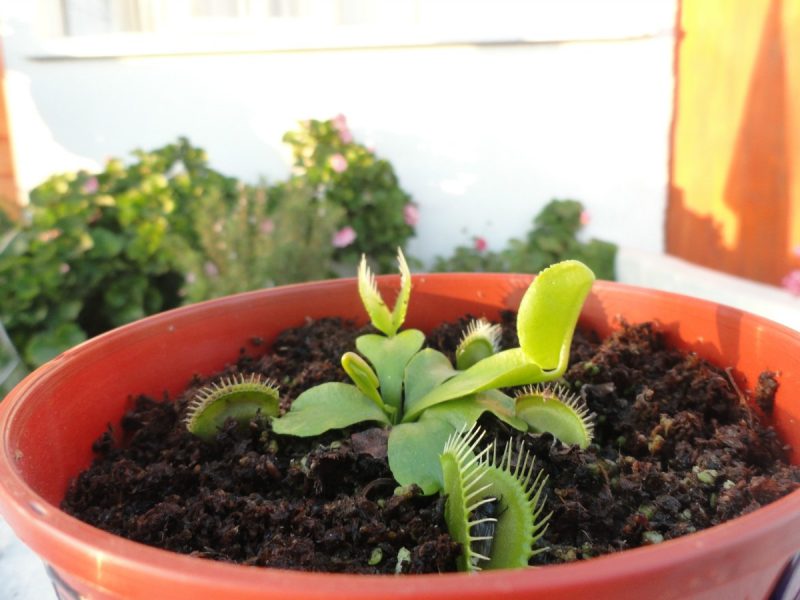
The flower requires careful handling. You can’t touch the traps with your hands; this makes them black and fall.If there is no desire to propagate Dionea seeds, it is better to prune the peduncle before flowering, which greatly depletes the plant, this is especially important for plants that have not gone through wintering.
Watering a plant
Proper watering is one of the conditions not only for the health of the Venus flytrap, but also for life.

It is carried out depending on the method of plant maintenance. The main patterns:
- watering only with distilled water;
- its temperature should not differ from the ambient temperature;
- use only the method of watering through a pallet;
- at room content, pour water into the pan with a layer of 0.5 cm every 1-2 days;
- if the flower is on the street, the water in the pan should always be, it is poured so that the water layer is at least 0.5 cm;
- water for irrigation is acidified by adding 1 drop of 99% formic acid per 10 l of water, but this should be done infrequently;
It is impossible to allow the substrate to dry out, the ground should be constantly moist, but it should not be brought to a state of dirt.
Fertilizer and fertilizer
This plant does not need traditional dressings for indoor flowers. Its food is living insects, but not any. You can feed Dionea flies, bees, she will not refuse spiders and even slugs. The size of the insect should be 2 times smaller than the trap, and better if they are very small. For the growing season, conducted in room conditions, only three feedings of 1 insect are enough. If Dionea spends the summer in the fresh air, you do not need to feed her - she will find food on the street herself. A plant purchased in a store is fed for the first time after 3-4 leaves regrowth under new conditions. In winter, the flower does not need nutrition.

How to transplant?
The frequency of transplants depends on the degree of mineralization of irrigation water. If the salts in it are less than 5 mg per 1 liter, then you can transplant after a year, otherwise you need an annual transplant. Spend it in late spring or early summer. How to transplant?
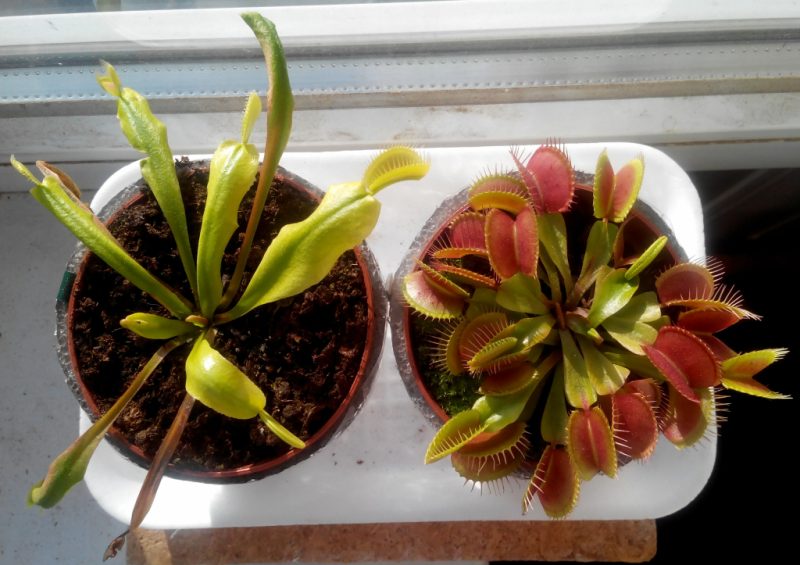
- A day before the transplant, spray the plant with Epin.
- Prepare a tall but not too wide pot with a lot of drainage holes.
- Cover a part of the pot with a substrate.
- Keep the plant above the bulbs without touching the traps.
- Immerse in a substrate so that all light parts are covered with it.
A plant purchased in a store is immediately transplanted into a self-prepared substrate, spilling it with Ribav-Extra.
Wintering
In this plant, the seasonality of vegetation is strongly expressed. Therefore, in the winter for 3-4 months it is in a state of deep dormancy. To prepare for wintering, Dionei needs to gradually, lowering the temperature and reducing daylight hours. It takes about a month to prepare. The optimum temperature for flower content is 0-5ºС. For the first wintering, it is slightly higher - 5-7 degrees Celsius. If the plant has already hibernated, it may be lower. The critical limit is minus 10 ºС.
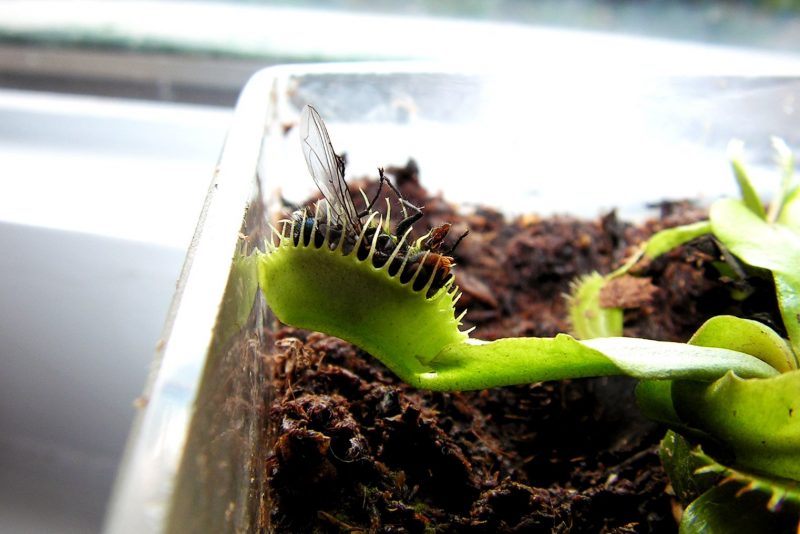
Dionea herself will tell you that she should go for the winter. With proper preparation, the leaves become wider and the traps small, horizontally arranged.
In the case of wintering at low positive temperatures, Dionea is watered into the pan if the top layer of the substrate dries out a little. At temperatures above plus 5 degrees, it is also illuminated with a single fluorescent lamp with cold light, suspended at a height of 20 cm above the flower, organizing it an eight-hour daylight. The water used to water the flower during this period should not differ in temperature from the surrounding air.
If there is no cold place for wintering in the room, the flower can be placed in the refrigerator for the rest period.
But first you need to prepare it:
- after reducing daylight hours and gradually lowering the temperature, the flower pot is shed with a fungicide diluted in distilled water (but only in cold), the flower itself is sprayed with a solution;
- put a plastic bag on the pot with it, in which 2 holes are made for ventilation;
- placed in a refrigerator, where the temperature is from 0 to 5 degrees;
- the plant does not need light at this time, but once a month it is necessary to moisten the top layer of the substrate with distilled water at the same temperature as in the refrigerator. After such a wintering, the plant should be transplanted into a new substrate, all dead leaves and traps are removed.
During the period of winter rest, Dionee does not need food.
Venus flytrap: breeding
Dione is propagated by daughter bulbs, sowing seeds and leafy cuttings. Before you figure out how to grow it from seeds collected from hybrid plants, you need to consider that future seedlings will not repeat the parental traits.
Cuttings
For propagation by cuttings, leaves are cut, cut as close as possible to the bulb with a sharp knife.

Cherenkovka process:
- lower the handle into a heteroauxin solution, the exposure time is 20 minutes;
- we sterilize peat;
- pour it into a container with drainage holes with a layer of 2 cm;
- we dip obliquely all white and a little green parts of the cuttings into peat moistened with a fungicide solution;
- we create greenhouse conditions - 100% humidity, a temperature of about 23ºС and maximum illumination.
After 5 weeks, the first leaves should appear, and after 3 months the plants are transplanted to a permanent place.
How to grow from seed?
If you want to collect seeds from your own plant, the flowers are pollinated with a soft brush, transferring pollen from the stamens to the pestle. If the flower is pollinated, it will quickly wither. Seeds are ready when the box begins to crack. They require stratification within 4 weeks, if just collected, and more than 6 weeks, if they lay longer than 3 months.
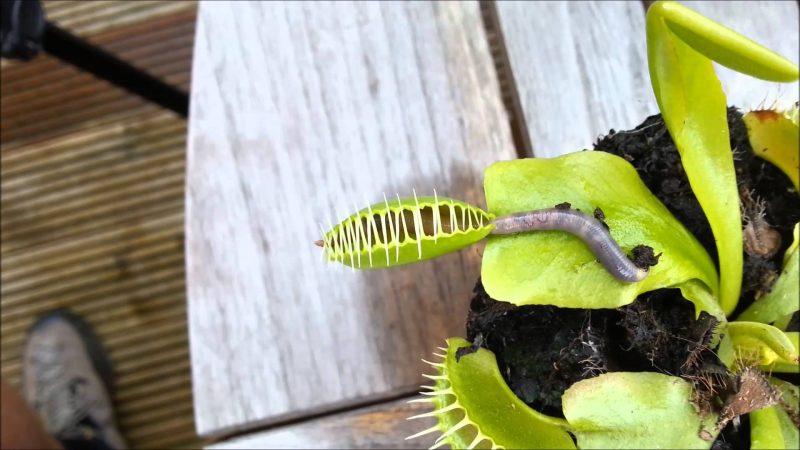
Stratification can be combined with sowing:
- sow sphagnum in humidified peat or moss in a pot;
- sprayed with fungicide;
- put in a sealed bag;
- put in the refrigerator, where the temperature is from 5 to 7 degrees;
- Do not forget to check for mold, fight with it diluted in distilled water with a temperature of 5 degrees "Maxim", then dust with colloidal sulfur;
- after 4-6 weeks we take out the pot and place it under fluorescent lamps with a daylight time of about 16 hours, temperature - 27ºС;
- when shoots appear, we begin to accustom them to the environment, gradually airing, then remove the package;
- we plant in 4-5 months.
Bulbs
Each bush of Dionea forms about 7 leaves, if their number is greater, the plant has children that can be separated during transplantation and planted in a separate pot. This is the best way to propagate hybrids - the new plant will be a copy of the parent.
Pest and Disease Control
When aphids appear on the plant, it is treated with insecticides, acaricides are used against the spider mite. Fungicides will cope with black soot fungus and gray rot.
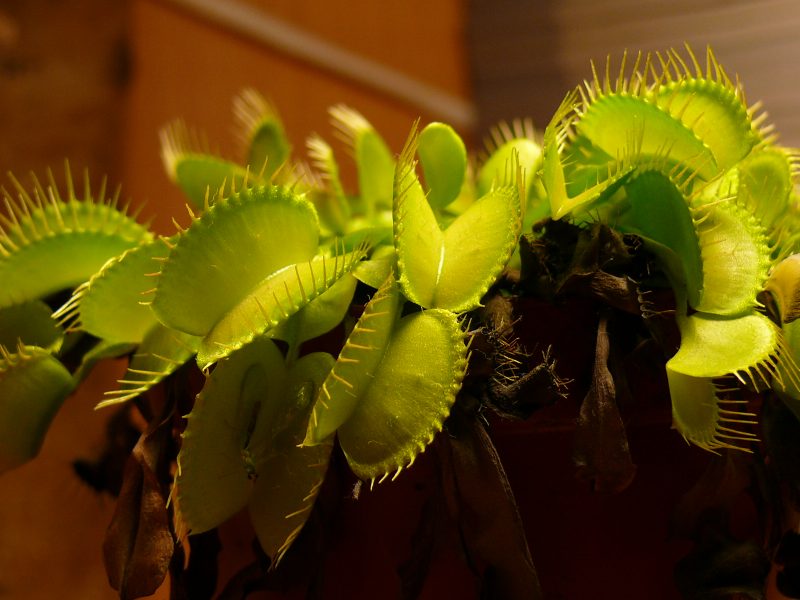
Possible growing problems
- With frequent irritation of the traps, they dry out, as they are designed for no more than 7 processes of digestion of food. Any rotted parts of the plant are cut to a healthy tissue, dusting the cut with crushed coal or colloidal sulfur.
- If Dionea leaves turn yellow, you need to change the water for irrigation to distilled. If the leaves not only turn yellow, but also fall, they correct watering in the direction of increase.
- If the leaves are stretched, and their bright color turns pale - the flower does not have enough light.












